8. Technical conditions of modern ornamental plant cultivation
Authors: Péter Honfi – Márk Steiner
8.1 Growing areas
Outdoor and greenhouse are two main sectors of ornamental cultivation, which differs not only in the location, but in the cultivated taxons and applied methods. Main areas of outdoor and greenhouse cultivation are reviewed in Chapter 1. In this chapter mainly – but not solely – devices and machines of greenhouse production are detailed, while nursery and perennial cultivation are specified in other chapters, only some of the applied techniques are detailed here.
8.1.1 Greenhouses
A greenhouse is a building, covered with light permeable coatings, in which plants are propagated, cultivated and horticultural growing is in process. Authors from abroad called covered facilities or conditioned environment. There are two types – according to coverage – glasshouses and foil buildings.
The basic function of greenhouses is providing adequate conditions for exotic plants in our climate, or plants, which are couldn’t cultivated or with less efficacy outdoors. First greenhouses were established in aristocratic and botanical gardens, with the role of keeping plants from exotic countries. These houses were served more as a representative, aesthetic buildings instead of cultivation purposes (see Chapter 1).
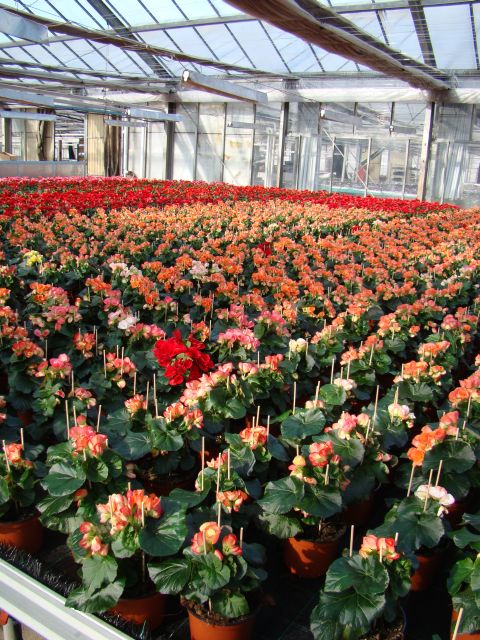
Potted begonias (Begonia elatior hybrids) in modern greenhouse
Most important types of greenhouses, used nowadays are foil houses, foil house blocks, traditional glasshouses and wide, high area glasshouses. Growing size of greenhouses is the general tendency of development. The advantage of this is homogenous heat delivery and better space utilization.
The coverage material of greenhouses is very diverse; besides glass cover other plastic materials came to the front.
Glasshouses . Glass has better longevity and light permeability than most plastics, but reflects UV radiation[1], which can cause elongation of the plants, and those, which are transplanted outside (for outdoor further growing or seedlings, potted plants) should be avoided from possible sunburn. Able to provide good control against heat emission during night, because re-radiate heat.
Film plastic greenhouses (Poly house) . The oldest technology of greenhouse cover is colourless plastic foil, mainly of polyethylene. Traditionally hoops pounded into the ground and the edges are fixed by pushing in the soil digged trench, which results a normal foil tunnel. It has a shorter longevity, cleaning is more difficult and can be contaminated easier than glass, moreover it is more sensitive, but does not absorbe UV, so elongation of the plants is rarer, and this technology is rather cheaper to build than a glasshouse. By the way heat management is less effective.
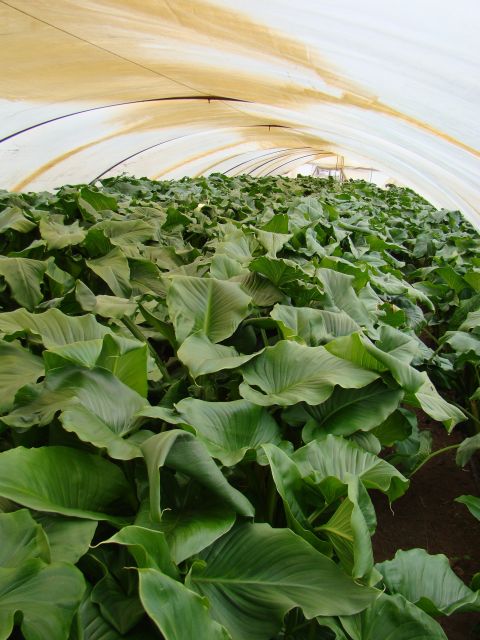
Cultivation of cut Zantedeschia aethiopica in plastic greenhouse
Double layer film plastic greenhouses . This method is improving heat management of the polyethilene foil, provides perfect heat isolation, can be ventillated or automatized. Establishment is much more expensive from traditional ones, but due to its advantages more commonly used. A special variety is the air inflated plastic greenhouse, where air between the two layers responsible for better heat isolation.
Rigid plastic covered greenhouses. Double wall plane and rigid plastics (policarbonate, poliacrilate) can be put on a similar frame, like glasshouses, but they are lightweight and better heat isolators. These materials are specifically expensive, which slowed down their spread in cultivation. Novel types receive a light resistant cover, thus not yellowing, and light permeability of them doesn’t decline.

Production of annual plants in greenhouse
8.2 Technical conditions to affecting light supply
Generally in greenhouse cultivation growers make an effort to increase light income of the house and to the growed plants. It is especially important in temperate zone during the lightless winter, when every possible tool should be used for increasing light supply. The easiest way is the choice of cover material, which is described above, but in addition it is relevant to build the construction of the house aiming to provide more light. The most important tool of this is the higher building (increasing post height), the use of slight structural elements, the location of shading devices on the floor, or under the tables and the good positioning.
Naturally occuring light is not sufficient in any of the cultures at any of the seasons therefore supplemental lighting can be utilized. The two basic types are: long-day treatment and assimilation lighting.
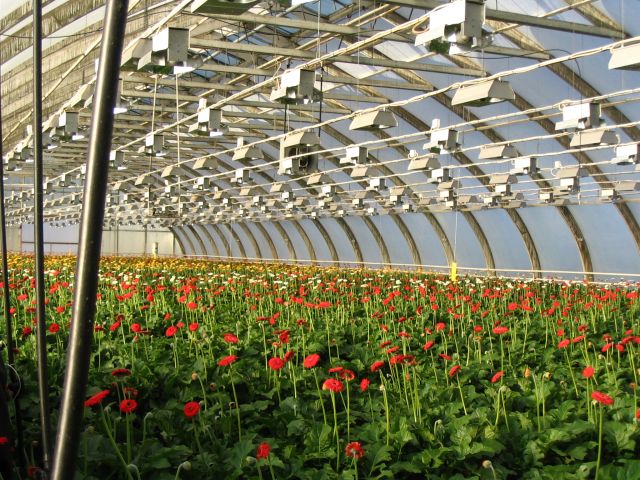
Production of cut gerbera in Finland , in greenhouse with assimilation lighting
Plant cultures of high light requirement are given high intensity assimilation lighting, for which usually 400 W high pressure sodium gas lights are used. The darkest the area of growing the more lighting is required. In Hungary 1 light source at every 18 squaremeters are located, at 3-4 m height above plant level. There is widespread use for flowering lilies and roses in winter.
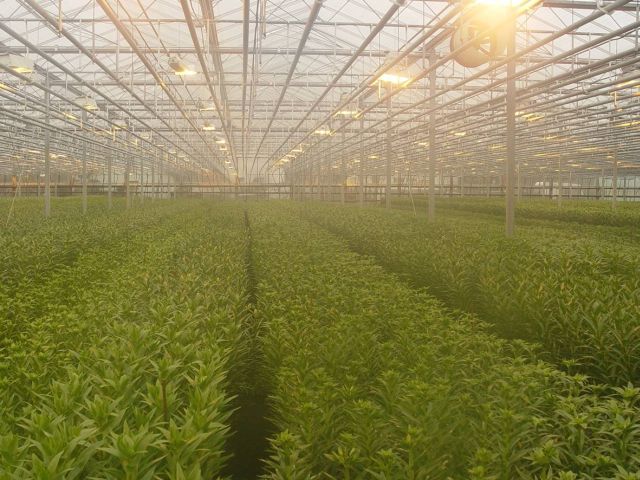
Assimilation lighting of cut lily production
Lamps or fluorescent tubes, which providing lower light intensity are adequate for long day treatment, as the aim is not promoting assimilation processes, but affecting development of photoperiodic plants sensitive to light duration, by elongating day length and shortening night. (Fore more details see Chapter 3)
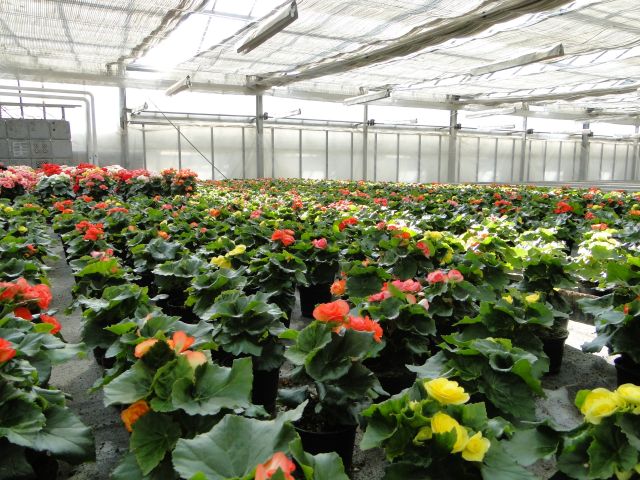
Greenhouse with fluorescent tubes for long-day treatment
Short day treatment (absolute exclusion of natural light) is required at the cultivation of short day plants (e.g. chrysanthemum, poinsettia, flaming Katy), in which day length can be shortened above critical. The easiest way is the black polyethylene shade cover above the plants. Beneath the shade heat can accumulate, therefore dislodging the cover after sunset has a crucial importance for aeration of the plants. Using textile instead of polyethylene has crop protection benefits and moreover helps ventillation. There is possibility to automatize the process, where shade cover is moving on an inner wire system, which is working in accordance to the installed time program under computer control.
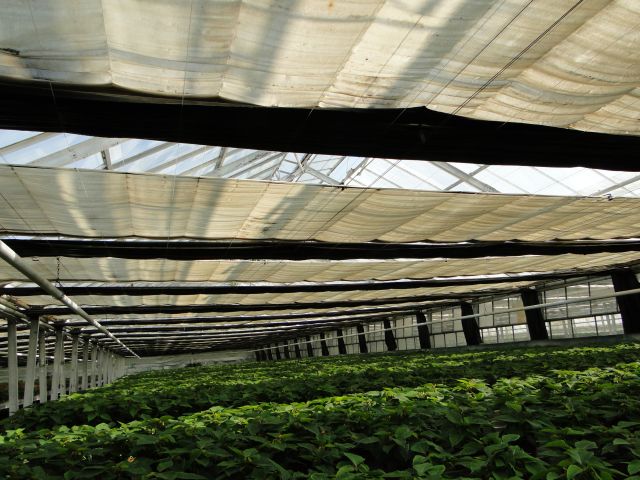
Greenhouse with shade cover
8.3 Improving greenhouse heat management
Besides light, temperature is a determining factor affecting development, therefore improving heat management of the greenhouse is a basically important question. There are two critical periods in the year: heat loss reduction and heating efficacy improvement is the main aim in winter, while during summer different tools are used to avoid overheating.
Air is responsible for heat isolation at double layer covering, which approve heat management of the house. Double film layer gives opportunity to spray water between the film layers, which heating in winter and cooling in summer.
Thermal screens are special plastic net systems, moving inside the greenhouse, which are horizontally above plant stock and vertically hanging nearby the side walls.
Aluminium strings are woven into its plastic material, which decrease heat loss from beneath by retain the heat. When the screen is pulled out it reduces the volume of air space to be heated, which also improving heating efficacy. They are drawn during the day to avoid shading, but in summer hot days – at the lack of shade screens – can also served for shading. When draw in the morning take care to do it stepped, as air space above can be cooled, which flows onto the plant stock.

Thermal sceens in greenhouse
When using vegetation heating warm water circulates in a plastic ribbed pipeline laid in the plant stock, which heats directly the plant environment, not the air space. To achieve this, lower water temperature than of normal heating is required (hot water would cause burn).
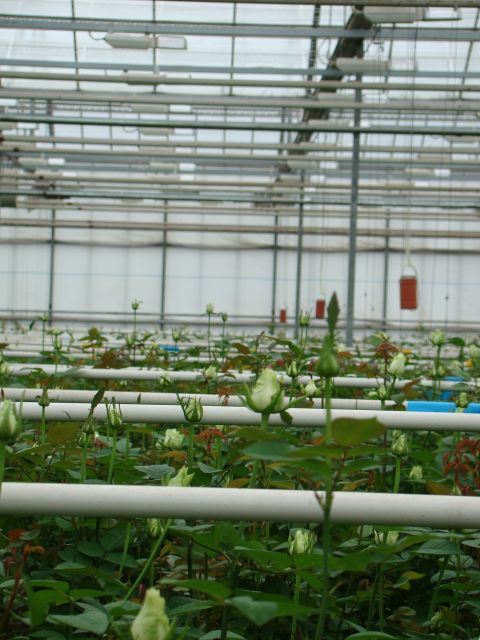
Vegetation heating in cut rose production
Overhead heating is a special vegetation heating used in some cut flower (rose, chrysanthemum) culture, where heating pipes are in the same height level as developing flower buds. The pipe is mobile, can be lifted when flower stem growing. Circulated water temperature is around 40 °C. Size of the flowers can increase, colours become more intense with the usage, moreover by drying buds, the possibility of grey mould decrease.
Underbench heating is a heating system, positioned below benches and tables, which used in plant propagation. This heating system results quicker rooting and germination, as temperature increase takes place directly at the environment of root development or germination, without heating the whole air space.
Shading is required during summer. Painting the greenhouse is the easisest way, which is cheap and such kind of paints can be bought, which degradate during summer and there is no need to rasp down in autumn. Other method is the usage of shading screens. This is a moveable white net, which can be bent above plant stock with wires, hereby reducing intensity of income light. Green raschel nets are also suitable tools for shading smaller buildings or outdoor beds, moreover creating shade canopies[2] is also possible.
Ventilation has a double aim: to avoid overheating by admitting cooler outside temperature and to provide air from outdoors richer in CO2, which maintain assimilation. Aeration units are usually at the top, by the vertebral or at the side walls of the greenhouse. Those, placed on the end wall of the building are not able to provide enough air change (this is the biggest problem with foil tunnels).
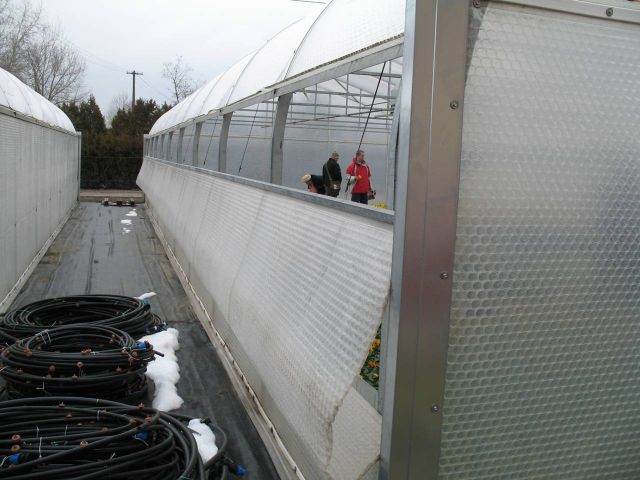
Ventilation of foil tunnels at the side of walls
Active cooling is required only in specific cases. Wet wall cooling is used at flowering of Cymbidium and in some carnathus house, where special formated cooling cells are put on walls and continously wimled with water, while at the opposite site axial high power ventillators are installed. The stimulated air ventilation move small sized water drops from the wet wall and send them through the building, while evaporation cools the environment.
8.4 Improving space utilization
Costs per square meter of the greenhouse can be reduced with methods and equipments aimed for improving space utilization, including indirectly machines and devices of internal logistics. The most elemental aim is to avoid or minimalize empty spaces, to eliminate neutral gear with good logistic and well prepared technological plans. It should be noted that there are period, when available technologies not enables economic growing. In these cases a short outage can be more profitable than establishing an uneconomic culture.
Forklifts. In greenhouses only special designed forklifts can be used for transporting materials owing to the narrow walks. So called CC-carts or Dutch carts are commonly used, which were developed for truck transport, because sizes are configured to completely fill out the truck stowage. The cart is 135 cm in length, 57 cm in width and 190 cm height. It roll on wheels, the supporting pillars are L-profile irons, where shelves can be added in a 10 cm scale depending on the size of the transported plants. In this manner, it is adequate for transporting either soliter plants or seedlings. It is dissassembled for storage or re-transport, with a minimum space consume.
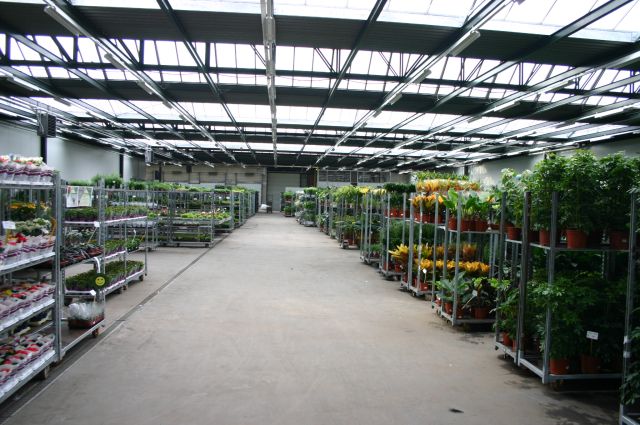
Pot plants in CC-carts
Rolling bench. Fix, standing, not moveable benches provide very bad space utilization. This technology is a thing of the past after introduction of rolling benches, which haven’t got fix legs, but can be rolled perpendicular to the bench lengthwise by a double steel roller. That’s why keeping ways are needed only at every 5-6 benches, therefore used area (netto growing area) rise up to 80-85 %.
Rolling palette. By the improvement of rolling bench, bench parts, trays (palettes) of plant growth become moveable in both directions. With this technology internal moving or outside movement from the greenhouse can be held without extra stowage. Space utilization can further develop, but in the other hand it is quite expensive.
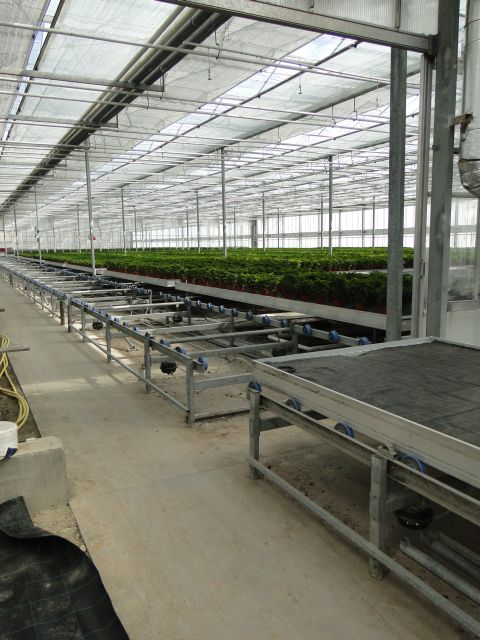
Greenhouse with rolling palettes
Hanging basket lines. Plants in tray, or potted plants in boxes or trays are moveable in hanging palettes in the greenhouse however construction of this technology is costly.
Conveyor belt, roller track. In industrial plant production (the so called seedling factory) conveyor belt and roller track can be found. The benefit of the latter ones are the possibility of dissassembling and assembling, so transport lines can be constructed on-demand, however only boxed materials can be transported, which vibrate during the transport. Softer transport can be held with conveyor belt, which is used commonly as a built in unit in some machines (e.g. potting machines, collators).
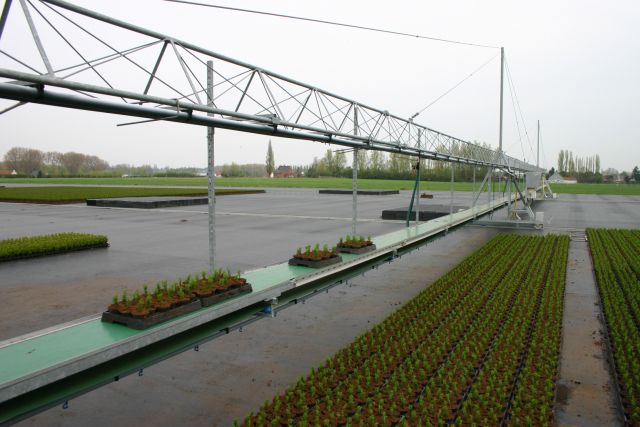
Roller track between greenhouse and open filed
8.5 Propagation- and transplanter machines
Soil mixing- and ground preparator machines . Elemental term of potting and propagation is the propagating or growing benches, filled with the required medium, or soil mixture. Several processes can be mechanized of composing and preparating the planting medium. Peat or soil mix, which comes in bales are slacked with bale breakers. A whole bale can put into each breaker, where the inside moving machinery breaks the consistent material and transported to soil mixing, potting, or propagating machine with a conveyor belt. Peat rolling machine is a special media preparation equipment. This machine serve for producing peat rolls, which are used in propagation (e.g. in cuttings). The machine fills paper roll with the media, than cut into pieces, which fit to seeding tray in size. More expensive pressed, water swelling peat pellets can be replaced with them.
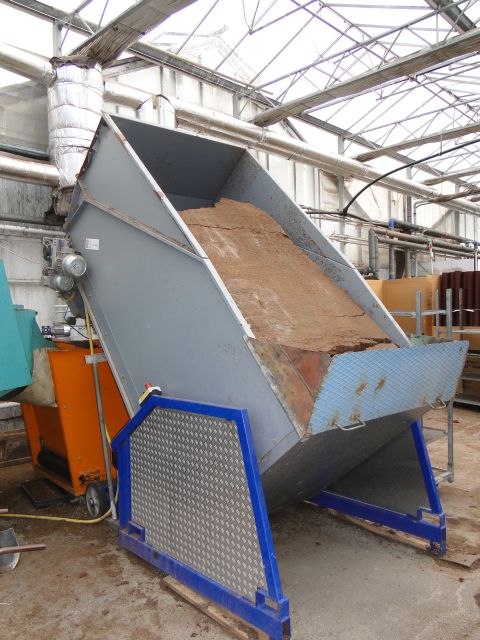
Soil mixing machine
Seeding machine. Seeding can be also held by machines. The equipment either does the filling of the trays, the precisious seeding and the cover. This method enable a very quick seeding, but not applicable for all of the seeds, too small ones have to be pelletted (seed covering) to be handleable for the machine, while seeds, with appendices, or which have special forms should be prepared by abrading, covering or pelleting.
Potting machines. Most commonly used potting machines are semi-automatic: filling the pots, which moves around in a circle, making the requested hole for the plant (seedling or cutting), but transplanting should be done by hand and runned out media and pot should be replaced.
Transplanting machines are mainly used in nurseries, where trencher blades or hole makers are put on a slowly moving equipment to prepare the hole for transplanting and plants are put manually to their place by operatives, who are sitting on the moving machine. This method is also applicable in greenhouse growing, by the way only rarely used. There is such kind of variety available, which making the plantation, at the most plant rationing should be held manually.
Planting robot. Fully automatic transplanting machines can be used in big volume potted growing and propagation, which are able to manage every operation of planting or transplanting. The fingered, robot-like equipment pulls out seedlings and cuttings from the tray and planting them into the pots that moving besides in a conveyor belt. In propagation mills and seedling factories filling of seedling tray are based on the same method: the seedling tray with seedlings or cuttings moves in front of, or under a photocell system, where photocell detects empty cavings (not germinated or died plant), which pulled out by a spike and robot fingers transplant the new plant.
Pot transfer machines. Pot transferring is a labour consuming process, where potted plants are put on a right spacing. Machinery systems have been also developed for this process. Plants coming from the roller track are catched from above by robot hands and pulled out singly or grouped, while after turning to the adjacent palette or bench the machine deposit them in a bigger spacing.
8.6 Irrigation- and fertilization machines
From plant caring procedures one of the most frequent works are irrigation and fertilization, therefore – with the lack of automatisation – needs very high labour. Most important methods in ornamental growing are the followings.
Tube irrigation. It is the least modern method, which consumes a lot of labour and needs a well experienced worker. It can be reasonable, where plant stock is mixed and different water requirement can be solved the easiest by this way, or in small growing volume, where automatisation is uneconomic.
Sprinkler irrigation. Irrigation plants from above are widely used method both in outdoor and greenhouse production. Depending on the used sprinkler heads the softness of water varying, in more sensitive cultures the softer sprinkle and the use of microsprinklers are advisable. The relatively big evaporation loss is the disadvantage of the method, by the way in this way increasing humidity of the surrounding area. Advantage is the easy installation and maintenance.

Mikrosprinklers irrigation in cut lily production
Subsurface textile irrigation / mat watering means that that potted grown plants (potted plants, annual seedlings, mother spawn, etc.) are placed on a textile, which keeps a part of irrigation water and therefore provide spare water for the plant. Tha main disadvantage is that textile should be changed not just because it become depleted but furthermore fungal diseases can establish.
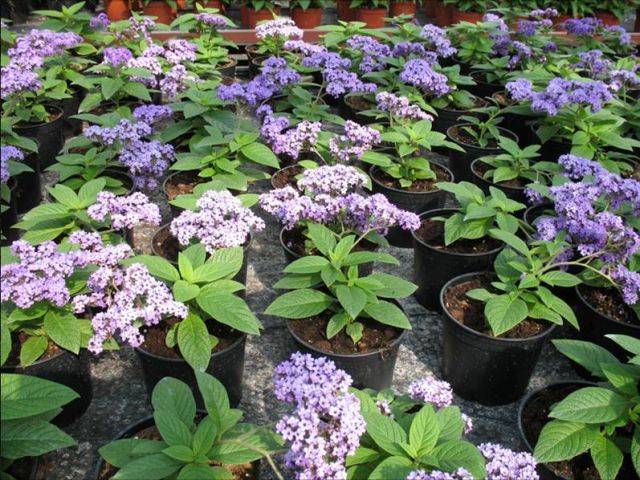
Subsurface textile irrigation of annual plants
In leaking irrigation water leaks into the soil or under the pots from perforated pipes laid in the plant culture –on the ground or bench. Enables to fully automatised, can be well combinated with textile irrigation.
In drip irrigation system pipes, running in the culture carrying water via distributors, sticked into the pipe through so called spaghetti tubes into the pots or (e.g. in hidroculture) into the spikes put at the base of plants, so fertilizers and irrigation water directly get to the root zone. This system has the best efficacy, but when using humidity management should be held.
Boom irrigation. A special equipment for potted plant and plantation growing. This is a watering boom with nozzles, which make a soft sprinkle. The boom is positioned perpendicular above the benches and moves there and back. When cultivated on the ground, it usually rolls in wheels, when plants are in benches, the boom runs along rails. The boom is propelled by a reel motor, according to the movement of the boom. Speed and frequency of irrigation can be modified based on the plants demand. The system runs continuosly in small pot cultures, while when bigger pots are used the boom stops above the rows and starts watering.
Ebb- and flood watering system. An irrigation and fertiliser system used for cultivation of potted plants in benches, where the water or fertiliser is pumped into the bench from beneath and after pots are moistured enough the solution is drained out into the tanks. Well automatisable and economic method, but drained out water should be filtered, moreover sterilisating can be worthy in order to avoid spreading of possible diseases.
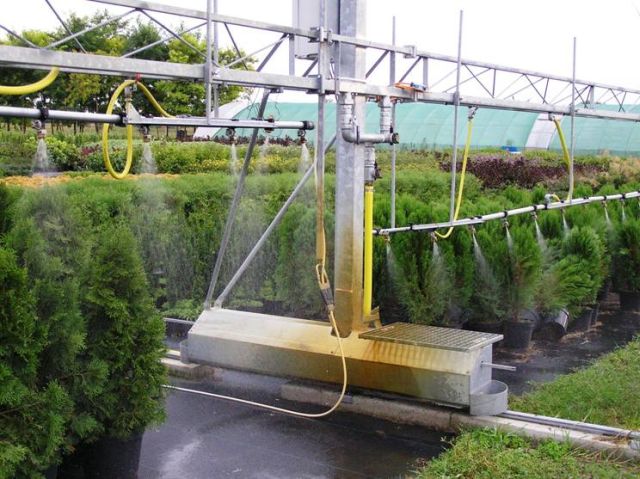
Irrigation boom in nursery
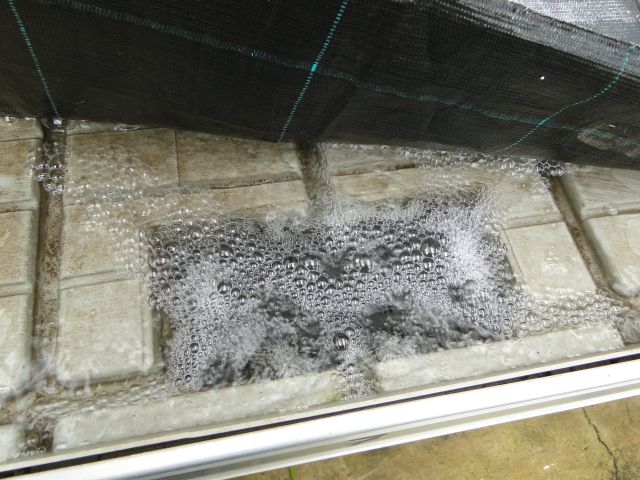
Ebb and flood watering system
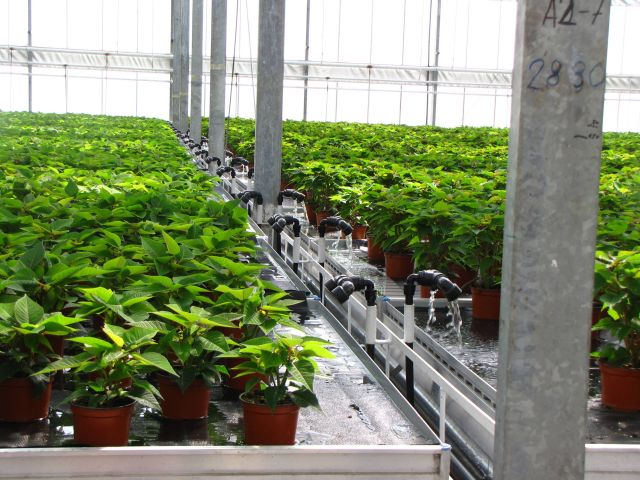
Ebb and flood watering system
Water cleaning equipments. The quality of tap water is usually adequate for ornamental cultivation however using is uneconomic owing to the high prices. Therefore most of the growers using other water sources. The easiest way to manage this is the collection of natural precipitation, which gives a perfect quality of water, but unfortunately usually not enough. The water, which comes from wells or surface waters have usually adequate quality after cleaning, therefore water cleaning equipments should be used. The functional principle is usually based on reverse osmosis[3], where flowing moves from contaminated water through a partially permeable membrane to the clear water. The membrane filters the contaminants, while let through the water. This flowing process, which based on different concentration enables isolation of contaminated and clear water. However residues are deposited on the surface of the membrane, the continuous water flow cleans up the filtered contaminants, therefore strangulation is impossible.
Dosatron . An easily handleable equipment of fertilizing. It is based on a T-shaped pipe, which horizontally connected to the water line, while the vertical pipe is dipped into the stock solution[4] (like in older varnishing machines). The water flow takes up the solution, the ratio can be determined at the bottom of the vertical pipe. Great advantage of the equipment that the amount of concentrate dispensed is proportional to the volume of water and irrespective of water pressure variations.
Computer controlled fertilization. The modernest fertilization system. Controllers are connected with three tanks, two of them containing (A-tank and B-tank) stock solution, while the third contains acid stock solution for pH regulation. Those nutrients are mixed in tank A and B, which not producing residues when react even in stock solution (residue: from reaction of water soluble compounds water insoluble compound is produced, which is not available for plants). The computer analyses backflow water and do the mixing in a ratio, which provides optimal nutrition for the plant culture.
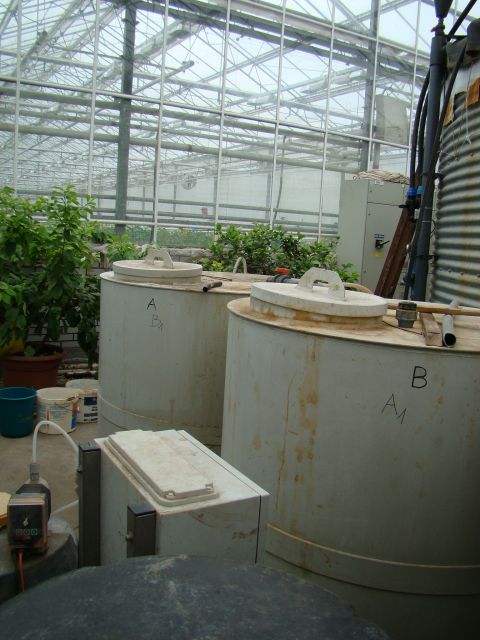
Tank A and B for computer controlled fertilization
8.7 Grading- and sorting machines
Grading- and sorting machines can be used at several phases of growing. The working principles of the machines can be physical or optical.
Physical grading machines are classifying the products based on some easely measurable parameter (mainly size, or weight). Most often it is used at onion production, where quality sorting of onions are based on different diameters.
Optical sorting machine makes picture from the foregone product and sorting by the visible characteristics of the product (colour, shade, foliage colour, shape, height / length etc.). By the computer controlled categories each product is put on the right boxes, which are located by a moving line (drop down to conveyor belt or lift out), while rubbish is removed. Able to provide very exact sorting, for example in cut rose sorting, where batching is also done and can be connected with packaging machine.
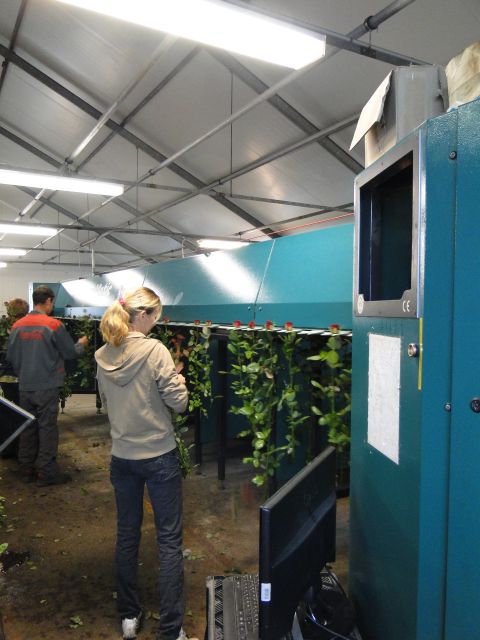
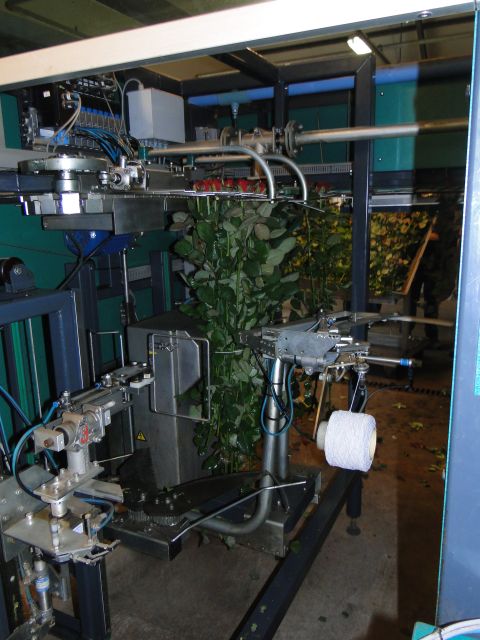
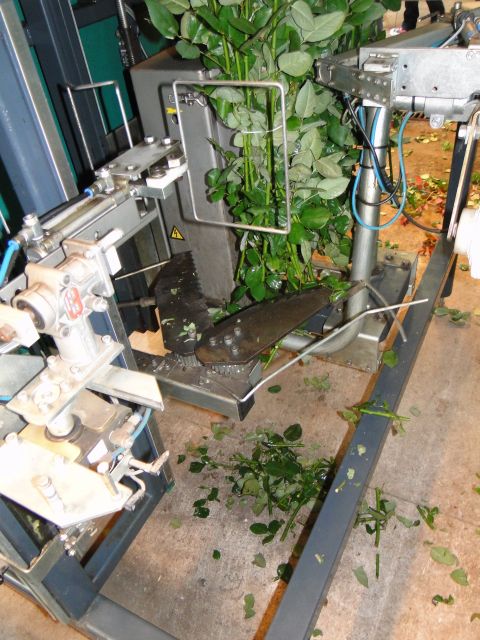
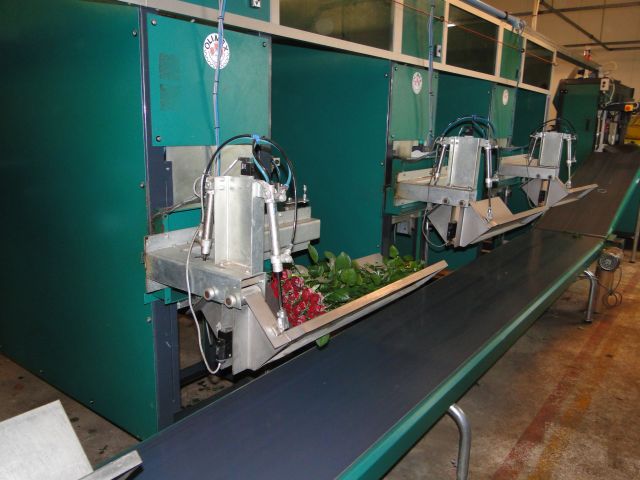
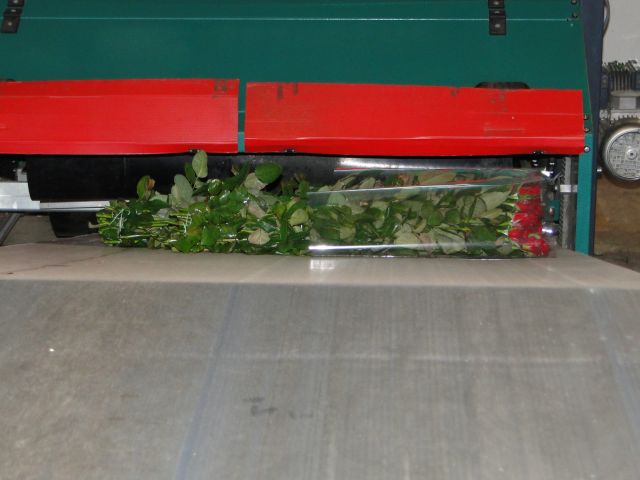
Grading- and sorting machine for roses
8.8 Climate control
Computer climate control system is an important tool of modern greenhouses, which provides optimal or close to optimal range of environmental conditions. The computer controls or able to control:
- heating,
- irrigation, fertilization and humidification,
- opening and closing of vents,
- cooling, aeration,
- shading,
- opening and closing of temperature screens,
- moving of shadeing screens,
- assimilation or long-day additional lighting,
- carbon dioxide fertilization[5],
- controlling and modifying the composition of fertilizers.
Computer control can be therefore more accurate than human, makes growing more effective, economic and provides quicker process. Not only automatized, programmed operations can be held by the computer but also able to intervent based on the measured charasteristics, inner or external parameters (temperature, wind velocity, humidity, soil moisture).
Installing climate control systems require high level expert and expertise and not allowed to neglect grower’s observations. Human attendance can not be ignored even the most precisely installed climate control system needs supervision and tuning.
8.9 Special elements of outdoor (nursery and perennial) cultivation
Similar or completely the same technical conditions should be provided in outdoor ornamental cultivation, like other horticultural sectors, by the way a part of formerly described equipments and machines are used, therefore only those equipments and facilities are demonstrated here, which are not or just rarely used in other cultures.
Perennial container production. Nowadays container production is the most frequently used perennial growing method, which had led to the shortening of growing duration and earlier marketing. Plants can be grown at huge numbers in a relatively small area.
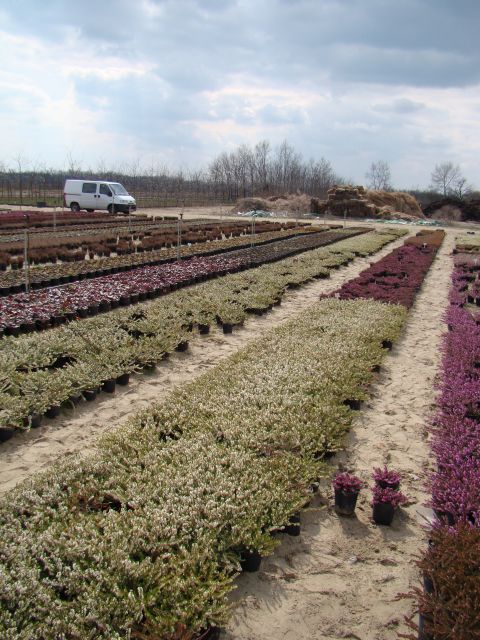
Perennial container production in Helvécia
The ground, where container stock is made should be free of weeds, mainly bedded and covered with geotextile. The land should be flat, a maximum of 2-3 % scope is allowed. Walks even between beds or different parts of the stock should be ensured, moreover water source possibility and semi-automatic or automatic irrigation system is required (modern growers using boom irrigation). If the grown plants require, shading possibility is also needed, which is mainly metal, with wires (see above), which also serve for wind protection.
Well drained, nutrient rich, well composed media is required for container production, which contains peat and compost.
Stratifying pit. This is a nursery establishment with a not translucent cover, in which stratification of the seeds take place (stratification: pre treatment of dormant seeds, which means cooled storage in moist media). Small seedlots can be stratified in pots (crock, container, box) digged 40-50 cm deep into the soil or in a cooler at 5 °C. Bigger seedlets can be stratified in pits, bigger cellars, or deep storage, covered with soil, sometimes in aboveground storage blocks (ventillated in summer, heatable during winter) or in nursery cold storage.
Pruning equipment. Mostly pneumatic pruning shears are used in nurseries, mainly for heading cut. The equipment reduces human force required to cut and the labour need up to 40 %.
Grafting machines. Tools, which ease down hand grafting, can have cutting- and rotating blades (e.g. omega-shaped), or blades for tongue grafting and rotating blades. There are machines, which join stock and scion, therefore only tying and waxing with paraffin should done manually. Spreading of grafting machines is limited due to the reduced success rate.
Lifting machines. Lifting is exhausting work in the nursery, which needs a great physical force, therefore mechanization is reasonable in small volume production as well. Several equipments can be used for lifting, from the simple lifting plough to unique rootballing machines.
- Lifting plough. Adjusted on tractor, towed or winched equipments, which lift up plants with L or U-shaped cutting-lifting blade. Efficacy of lifting and root cleaning can be improved with sliding sticks or jarring machineries.
- Bed lifting machines. Special equipment, which lifts up, ploughs the whole bed in one way, with on direction moving plough share and shakers. Saplings stand straight on the ground after machine moved away and can be collected easily.
- Lifting-batching machine. A kind of lifting machine, where lifted saplings are moved to a connected batching machine with oppositely moving rubber stripes, or the machine put the plants in swath.
- Unique lifting of bare root[6] trees. In ornamental nurseries it is used to lift out bigger trees uniquely. The main element is a blade turneable through 180°, which makes the cutting of roots and a supporter blade recessed into soil with hydraulic cylinder, which compensate sideward pressure. After cutting the roots the equipment lift up the tree with the blade. The tree is kept by a padded clamping device and it shakes off the soil from the root zone. The capacity of the machine is 60-120 trees per hour.
- Unique rootballing machine. Embossed cutting blade, equipped with hydraulic digging tools, able to lift out oversized trees in rootball. The working principle is: from the requested distance from the trunk cutting blades cut the roots from up to down and making undercutting as well. The height of the rootball is adjustable. An elevator stand pull out the tree with the rootball, packaging should be done manually.
Literature
- Ball, V. 1997. BallRedbook. Greenhouse Growing. Prentice Hall Inc., Engelwood Cliffs, New Jersey, USA.
- Horn, W. (szerk.) 1996. Zierpflanzenbau. Blackwell Wissenschaftsverlag, Berlin-Wien.
- Schmidt G. 2011. Az üveg és fólia alatti dísznövénytermesztés berendezései és gépei. In: Tillyné Mándy A. és Honfi P. (szerk.) Növényházi dísznövénytermesztés. Egyetemi jegyzet. Budapesti Corvinus Egyetem, Kertészettudományi Kar, Budapest.
[1] ultraviolet, shortly UV-radiation is electromagnetic radiation with a wavelength shorter than that of visible light (400nm), but longer than X-rays, in the range of 200-400 nm
[2] shade canopy: outdoor shade net on wooden or firm construction
[3] osmosis: is the net movement of solvent molecules through a partially permeable membrane into a region of higher solute concentration, in order to equalize the solute concentrations on the two sides
[4] stock solution: it is a 100 or 1000 times concentrated solution, whereby the requested fertilizer concentration is made by dilution
[5] carbon dioxide fertilization: fertilization method for greenhouse growing, where air, rich in CO2 is moved into the atmosphere of the greenhouse to reinstate gas, which was extracted during photosynthesis and stimulate plants for increased assimilation
[6] bare root: dug out tree, where root system is cleaned from soil

